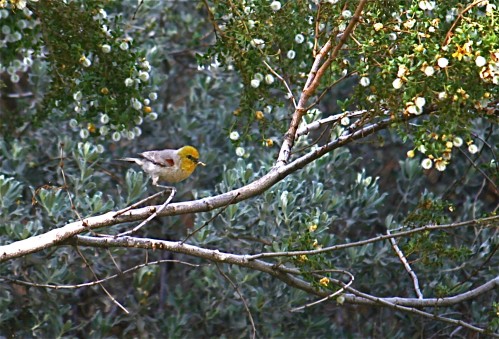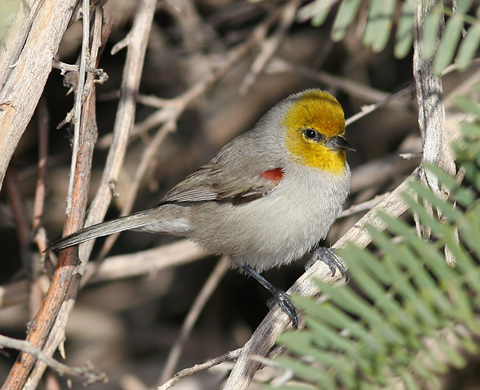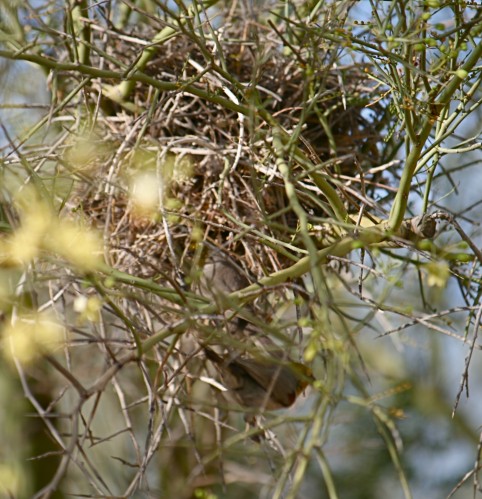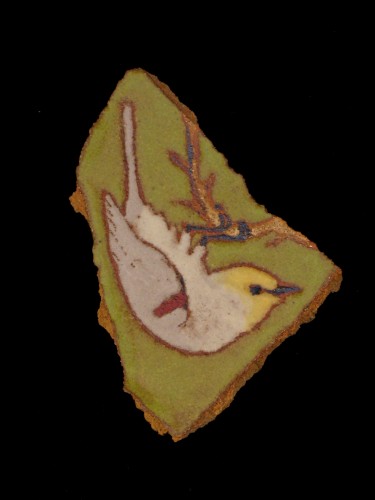Yard list: Dinky Dudes of the Desert
When I left the Mississippi River Valley to come back to the West, I thought, Hmmmmm, no chickadees in the low desert. What’s that going to be like?
We were very accustomed to Carolina chickadees as ever-present “fee-bay-fee-bee”-ers in our St. Louis yard. They accompanied us on hikes; we heard them in the parks, they were everywhere, all year round — active little birds that deserve the gooey description “perky”, sociable to the point of seeming to boldly hang with people if there was seed to be had (safflower, yum!), or nesting fluff (white dog hair, good!). And in Berkeley and Santa Cruz, we’d encountered Chestnut-backed Chickadees frequently. So when we got to Phoenix it seemed strange to not have “dees” about the place.
But we didn’t need to worry — here we have Verdin (Auriparus flaviceps). The default little gray bird of the Sonoran desert is taxonomically unrelated to chickadees, but they are superficially like them in that they are small, predominantly gray, active birds who are common permanent residents in their habitat, vocal, and fairly unabashed by humans. In fact, though they aren’t related, the Verdin’s genus, Auriparus, means “golden parid”, or chickadee-like bird (Chickadees and Titmice are members of the family Paridae.)
but they are superficially like them in that they are small, predominantly gray, active birds who are common permanent residents in their habitat, vocal, and fairly unabashed by humans. In fact, though they aren’t related, the Verdin’s genus, Auriparus, means “golden parid”, or chickadee-like bird (Chickadees and Titmice are members of the family Paridae.)
“Small” may not be emphatic enough: tiny, or even dinky (the technical term) is more like it. Verdin are in fact among the smallest of North American song birds: bigger than hummingbirds, but that’s about it. They flit and glean busily among the thorny green-branched desert trees emitting chip notes and a three-note call that’s frequent and loud considering the size of its source. Their sounds, along with the mechanical Drr-brrr-drr-brr-drr of cactus wrens and the Curve-billed thrasher’s quick “whit-wheat”, means home to me.
The photo at the top of the post, taken in our yard, is of a male doing nestling-feeding duties — you can see he’s got a little something in his beak. He was so busy he allowed me to approach fairly closely, and you can see one of the most excellent things about Verdin: the color of their head. They aren’t called “flaviceps” (Latin for “yellow-head”) for nothing. But it’s not just yellow, it’s a very particular sort of golden yellow — slightly green and  slightly gray, too, mustard, perhaps, and by some amazing biological coincidence, it’s exactly the color of Creosote blossoms, as if the birds used them to powder their heads. The bird above is in a creosote bush (Larrea tridentata), and though most of the blooms have become white seed puffs, you can still see a few yellow flowers over the Verdin’s back. They exactly match his head. You can also see another colorful field mark, his sharp little chestnut epaulette. Both the head color and the epaulette are vivid in the close-up image here (photo by T.Beth Kinsey, from the always excellent Firefly Forest). Notice the narrow, sharp beak of a gleaner, rather than the sturdy beak of a seed-cracker.
slightly gray, too, mustard, perhaps, and by some amazing biological coincidence, it’s exactly the color of Creosote blossoms, as if the birds used them to powder their heads. The bird above is in a creosote bush (Larrea tridentata), and though most of the blooms have become white seed puffs, you can still see a few yellow flowers over the Verdin’s back. They exactly match his head. You can also see another colorful field mark, his sharp little chestnut epaulette. Both the head color and the epaulette are vivid in the close-up image here (photo by T.Beth Kinsey, from the always excellent Firefly Forest). Notice the narrow, sharp beak of a gleaner, rather than the sturdy beak of a seed-cracker.
As bright as these plumage features seem in photos, they are not always easily seen in the field, unless you’re equipped with binoculars. So, many folks don’t notice this industrious little desert-gleaner working above their heads in their xeric yards. What is very easily seen are the nests of Verdins — messy round stick-wads built in thorny trees and shrubs, often placed out towards the end of branches, to catch cooling breezes. Verdin are prolific nest-builders, and often  have a couple underway at the same time. They build both breeding nests and roosting nests, and you might say they’ve got a complex nest-culture. The male starts a sample nest which the female helps him finish, probably strengthening the pair bond. Here’s a photo of an active breeding nest in our yard with noisy hatchlings in it. The adult birds are hard to pick out, but the same little gray papa in the top photo is hanging in the “front door” along with the female — you have to imagine away the foreground branch of the Little leaf Palo Verde that’s blooming. The nest is the wad of brown sticks against the blue sky, and the nest opening is at the bottom of the wad, which is where you can see the gray backs of the parents (click to enlarge the photo; it’s easier to see the birds). The low placement of the nest openings make them rain-sheltered and somewhat protected from larger winged predators.
have a couple underway at the same time. They build both breeding nests and roosting nests, and you might say they’ve got a complex nest-culture. The male starts a sample nest which the female helps him finish, probably strengthening the pair bond. Here’s a photo of an active breeding nest in our yard with noisy hatchlings in it. The adult birds are hard to pick out, but the same little gray papa in the top photo is hanging in the “front door” along with the female — you have to imagine away the foreground branch of the Little leaf Palo Verde that’s blooming. The nest is the wad of brown sticks against the blue sky, and the nest opening is at the bottom of the wad, which is where you can see the gray backs of the parents (click to enlarge the photo; it’s easier to see the birds). The low placement of the nest openings make them rain-sheltered and somewhat protected from larger winged predators.
The materials Verdin use for the exterior of their nests are the same ones Cactus wrens prefer for their own, so Verdin nests under construction in spring are often the focal point of theiving-and-chasing interaction between the two species. In general, Cactus wrens seem to enrage Verdin, and the smaller birds will gang up on any wren they find in their area — nesting material isn’t the only thing Cactus wrens will snatch out of Verdin nests.
Verdins enjoy a variety of food sources besides gleaning bugs and larvae from foliage. They take a sip of nectar now and again, and often hop around inside the stems of Chuparosa, robbing the sweet nectar from the base of the red flowers (they’re delicious — pop a whole Chuparosa flower into your mouth sometime; they taste like sweet cucumbers). And we frequently see them hanging upside down from the hummingbird feeders, sipping the drips on the bottom after the sloppy Gila woodpeckers are through. This acrobatic hanging upside down of Verdins is a family trait — they are the only North American representative of the family Remizidae, or Penduline tits. Whatever that may sound like, it actually means little birds that hang upside down.
So, although the desert has no chickadees, we’ve got other little gray birds. ( And I haven’t even mentioned gnatcatchers, Bushtits, and Lucy’s warblers…) But Arizona is not “dee-free”. When we need a hit of chickadee or titmouse, we have choices — there is actually one more species of Paridae here than in the Midwest: Mountain chickadees in the high pine forests above the Mogollon Rim, Juniper titmice on the Colorado Plateau, the fantastic Bridled titmouse (yes, its ornate facial markings put the Plain titmouse to shame!) in the evergreen oak woodlands of the foothills and mountains of central and southern Arizona, and even a small population of Mexican chickadees in the Chiricahua Mountains of southeastern Arizona. All we need to do is go uphill and it’s ‘Dee-a-Rama!


I saw one of these this morning. 🙂